Consumers’ Acceptance of a Bio-circular Automotive Economy: Explanatory Model and Influence Factors
Abstract
:1. Introduction
1.1. Motivation for This Research
1.2. Research Gaps and Objectives
- How can the acceptance of sustainable tyres be modelled?
- What are consumers’ needs and interests with regards to tyres and sustainability?
1.3. Novelty of This Research
2. Materials and Methods
3. Results
3.1. Acceptance Model
3.1.1. Foundations and Fundamental Variables
3.1.2. Benefit and Simplicity Variables
3.1.3. Moderator Variables
3.2. Specific Acceptance Variables
- External variables regarding consumer attitudes and typologies (A);
- Perceived product characteristics: benefits and simplicity of the purchase (B); as well as
- Information on benefits and simplicity to specify the moderator variables (C).
3.2.1. External Variables Related to the Consumers
3.2.2. Perceived Product Characteristics
3.2.3. Moderator Variables
4. Discussion
4.1. Summary of Findings
- How can the acceptance of sustainable tyres be modelled?
- What are consumers’ needs and interests with regards to tyres and sustainability?
4.2. Managerial Implications
4.3. Implications for Policy Makers
4.4. Limitations
Author Contributions
Funding
Conflicts of Interest
Appendix A
| Contribution | ||
| Research objective | ||
| Most important statements | ||
| Biobased properties of the product | ||
| CE-based properties of the product | ||
| Aspects of acceptance | Included yes/no | Description |
| Stakeholder groups considered | ||
| Private consumers | ||
| Companies | ||
| Other | ||
| General acceptance factors | ||
| Price | ||
| Functionality | ||
| Miscellaneous | ||
| Socio-economic acceptance factors | ||
| Environmental acceptance factors | ||
| Legal framework conditions | ||
| Norms and standards | ||
| Certificates and labels | ||
| Special framework conditions | ||
| Other remarks | ||
| Summary | ||
References
- Hiebel, M.; Bertling, J.; Nühlen, J.; Pflaum, H.; Somborn-Schulz, A.; Franke, M.; Reh, K.; Kroop, S. Studie zur Circular Economy im Hinblick auf die chemische Industrie. Available online: http://publica.fraunhofer.de/eprints/urn_nbn_de_0011-n-4769003.pdf (accessed on 20 November 2019).
- Directive, L. Council Directive 1999/31/ECof 26 April 1999 on the landfill of waste. Off. J. Eur. Communities 1999, 182, 1–19. [Google Scholar]
- European Commission. Circular Economy. Available online: https://ec.europa.eu/growth/industry/sustainability/circular-economy_en (accessed on 27 February 2020).
- European Parliament and the Council. Directive 2008/98/EC on Waste (Waste Framework Directive); European Parliament and the Council: Brussels, Belgium, 2016. [Google Scholar]
- ETRMA. End-of-life Tyre Report 2015. Available online: https://www.etrma.org/wp-content/uploads/2019/09/elt-report-v9a-final.pdf (accessed on 20 November 2019).
- JATMA. Tyre Industry of Japan. Available online: http://www.jatma.or.jp/media/pdf/tyre_industry_2019.pdf (accessed on 26 November 2019).
- MDPI. Sustainability Transition Towards a Bio-Based Economy: New Technologies, New Products, New Policies; Morone, P., Ed.; MDPI: Basel, Switzerland; Beijing, China; Wuhan, China; Barcelona, Spain; Belgrade, Serbia, 2018. [Google Scholar]
- CEN. Bio-Based Products—Vocabulary; EN 16575:2014; NSAI: Dublin, Ireland, 2014. [Google Scholar]
- Walter, C. PS Welt Materialcheck. Was Taugen Runderneuerte Reifen wirklich? Available online: https://www.welt.de/motor/article138565689/Was-taugen-runderneuerte-Reifen-wirklich.html (accessed on 26 November 2019).
- Stanojevic, D.; Rajkovic, M.; Toskovic, D. Management of used tires, accomplishments in the world and situation in Serbia. Hem. Ind. 2011, 65, 727–738. [Google Scholar] [CrossRef]
- Dabic-Ostojic, S.; Simic, V.; Miljuš, M. Used Tire Management: An Overview. In Proceedings of the Logistics International Conference, Belgrade, Serbia, 25–27 May 2017. Part I. 3rd. [Google Scholar]
- Simic, V.; Dabic-Ostojic, S. Used tire management: An Overview. In Proceedings of the Logistics International Conference, Belgrade, Serbia, 25–27 May 2017. Part II. 3rd. [Google Scholar]
- Davis, F.D. Perceived Usefulness, Perceived Ease of Use, and User Acceptance of Information Technology. MIS Q. 1989, 13, 319. [Google Scholar] [CrossRef] [Green Version]
- Taherdoost, H. A review of technology acceptance and adoption models and theories. Procedia Manuf. 2018, 22, 960–967. [Google Scholar] [CrossRef]
- Adnan, N.; Nordin, S.M.; Rahman, I.; Vasant, P.M.; Noor, A. A comprehensive review on theoretical framework based electric vehicle consumer adoption research. Int. J. Energy Res. 2017, 41, 317–335. [Google Scholar] [CrossRef]
- Bhate, S.; Lawler, K. Environmentally friendly products: Factors that influence their adoption. Technovation 1997, 17, 457–465. [Google Scholar] [CrossRef]
- Axsen, J.; TyreeHageman, J.; Lentz, A. Lifestyle practices and pro-environmental technology. Ecol. Econ. 2012, 82, 64–74. [Google Scholar] [CrossRef]
- Bossle, M.B.; De Barcellos, M.D.; Vieira, L.M.; Sauvée, L. The drivers for adoption of eco-innovation. J. Clean. Prod. 2016, 113, 861–872. [Google Scholar] [CrossRef]
- Medeiros, J.F.; de Ribeiro, J.L.D.; Cortimiglia, M.N. Success factors for environmentally sustainable product innovation: A systematic literature review. J. Clean. Prod. 2014, 65, 76–86. [Google Scholar] [CrossRef]
- Hanss, D.; Böhm, G. Sustainability seen from the perspective of consumers. Int. J. Consum. Stud. 2012, 36, 678–687. [Google Scholar] [CrossRef]
- Liobikienė, G.; Grincevičienė, Š.; Bernatonienė, J. Environmentally friendly behaviour and green purchase in Austria and Lithuania. J. Clean. Prod. 2017, 142, 3789–3797. [Google Scholar] [CrossRef]
- Liobikienė, G.; Juknys, R. The role of values, environmental risk perception, awareness of consequences, and willingness to assume responsibility for environmentally-friendly behaviour: The Lithuanian case. J. Clean. Prod. 2016, 112, 3413–3422. [Google Scholar] [CrossRef]
- Luchs, M.G.; Kumar, M. Yes, but this Other One Looks Better/Works Better: How do Consumers Respond to Trade-offs Between Sustainability and Other Valued Attributes? J. Bus. Ethics 2017, 140, 567–584. [Google Scholar] [CrossRef]
- Bröring, S.; Baum, C.M.; Butkowski, O.K.; Kircher, M. Kriterien für den Erfolg der Bioökonomie. In Bioökonomie für Einsteiger; Springer: Berlin/Heidelberg, Germany, 2017; Volume 50, pp. 159–175. [Google Scholar]
- Camacho-Otero, J.; Boks, C.; Pettersen, I. Consumption in the Circular Economy: A Literature Review. Sustainability 2018, 10, 2758. [Google Scholar] [CrossRef] [Green Version]
- Camacho-Otero, J.; Pettersen, I.N.; Boks, C. Consumer and User Acceptance in the Circular Economy: What are Researchers Missing? PLATE 2017, 65–69. [Google Scholar] [CrossRef]
- Russo, I.; Confente, I.; Scarpi, D.; Hazen, B.T. From trash to treasure: The impact of consumer perception of bio-waste products in closed-loop supply chains. J. Clean. Prod. 2019, 218, 966–974. [Google Scholar] [CrossRef]
- Sijtsema, S.J.; Onwezen, M.C.; Reinders, M.J.; Dagevos, H.; Partanen, A.; Meeusen, M. Consumer perception of bio-based products—An exploratory study in 5 European countries. NJAS - Wagening. J. Life Sci. 2016, 77, 61–69. [Google Scholar] [CrossRef]
- Carus, M.; Eder, A.; Beckmann, J. Green Premium Prices along the Value Chain of Biobased Products. Ind. Biotechnol. 2014, 10, 83–88. [Google Scholar] [CrossRef]
- Lettner, M.; Schöggl, J.-P.; Stern, T. Factors influencing the market diffusion of bio-based plastics: Results of four comparative scenario analyses. J. Clean. Prod. 2017, 157, 289–298. [Google Scholar] [CrossRef]
- Peuckert, J.; Quitzow, R. Acceptance of bio-based products in the business-to-business market and public procurement: Expert survey results. Biofuels Bioprod. Bioref. 2017, 11, 92–109. [Google Scholar] [CrossRef]
- Schuitema, G.; Anable, J.; Skippon, S.; Kinnear, N. The role of instrumental, hedonic and symbolic attributes in the intention to adopt electric vehicles. Transp. Res. Part A Policy Pract. 2013, 48, 39–49. [Google Scholar] [CrossRef]
- Egbue, O.; Long, S. Barriers to widespread adoption of electric vehicles: An analysis of consumer attitudes and perceptions. Energy Policy 2012, 48, 717–729. [Google Scholar] [CrossRef]
- Li, W.; Long, R.; Chen, H.; Geng, J. A review of factors influencing consumer intentions to adopt battery electric vehicles. Renew. Sustain. Energy Rev. 2017, 78, 318–328. [Google Scholar] [CrossRef]
- Liao, F.; Molin, E.; van Wee, B. Consumer preferences for electric vehicles: A literature review. Transp. Rev. 2017, 37, 252–275. [Google Scholar] [CrossRef] [Green Version]
- Moons, I.; de Pelsmacker, P. The Effect of Evoked Feelings and Cognitions, Parent Brand Fit, Experiences and Brand Personality on the Adoption Intention of Branded Electric Cars for Early and Late Adopter Segments. In Advances in Advertising Research Vol. IV; Verlegh, P., Voorveld, H., Eisend, M., Eds.; Gabler: Wiesbaden, Germany, 2016; Volume 54, pp. 395–406. [Google Scholar]
- Lanzini, P.; Testa, F.; Iraldo, F. Factors affecting drivers’ willingness to pay for biofuels: The case of Italy. J. Clean. Prod. 2016, 112, 2684–2692. [Google Scholar] [CrossRef] [Green Version]
- Linzenich, A.; Arning, K.; Bongartz, D.; Mitsos, A.; Ziefle, M. What fuels the adoption of alternative fuels? Examining preferences of German car drivers for fuel innovations. Appl. Energy 2019, 249, 222–236. [Google Scholar] [CrossRef]
- Chang, D.-S.; Chen, S.-H.; Hsu, C.-W.; Hu, A.H.; Tzeng, G.H. Evaluation Framework for Alternative Fuel Vehicles: Sustainable Development Perspective. Sustainability 2015, 7, 11570–11594. [Google Scholar] [CrossRef] [Green Version]
- Li, T.; McCluskey, J.J. Consumer Preferences for Second-Generation Bioethanol. In Proceedings of the Selected Paper Prepared for Presentation at the Agricultural & Applied Economics Association’s 2014 AAEA Annual Meeting, Minneapolis, MN, USA, 27–29 July 2014. [Google Scholar]
- Li, T.; McCluskey, J.J. Consumer preferences for second-generation bioethanol. Energy Econ. 2017, 61, 1–7. [Google Scholar] [CrossRef] [Green Version]
- Moula, M.M.E.; Nyári, J.; Bartel, A. Public acceptance of biofuels in the transport sector in Finland. Int. J. Sustain. Built Environ. 2017, 6, 434–441. [Google Scholar] [CrossRef]
- Despeisse, M.; Kishita, Y.; Nakano, M.; Barwood, M. Towards a Circular Economy for End-of-Life Vehicles: A Comparative Study UK–Japan. Procedia CIRP 2015, 29, 668–673. [Google Scholar] [CrossRef]
- Mihet-Popa, L.; Saponara, S. Toward Green Vehicles Digitalization for the Next Generation of Connected and Electrified Transport Systems. Energies 2018, 11, 3124. [Google Scholar] [CrossRef] [Green Version]
- Tarne, P.; Traverso, M.; Finkbeiner, M. Review of Life Cycle Sustainability Assessment and Potential for Its Adoption at an Automotive Company. Sustainability 2017, 9, 670. [Google Scholar] [CrossRef] [Green Version]
- Wang, Y.; Huscroft, J.R.; Hazen, B.T.; Zhang, M. Green information, green certification and consumer perceptions of remanufctured automobile parts. Resour. Conserv. Recycl. 2018, 128, 187–196. [Google Scholar] [CrossRef]
- Popper, K. Alles Leben Ist Problemlösen; Piper: München, Germany, 1994. [Google Scholar]
- Popper, K. Auf Der Suche Nach Einer Besseren Welt; Piper: München, Germany, 1984. [Google Scholar]
- Dillon, A.; Morris, M.G. User acceptance of new information technology: Theories and models. In Annual Review of Information Science and Technology; Information Today: Medford, NJ, USA, 1996; pp. 3–32. [Google Scholar]
- Ajzen, I. The theory of planned behavior. Organ. Behav. Hum. Decis. Process. 1991, 25, 179–211. [Google Scholar] [CrossRef]
- Ajzen, I. The theory of planned behaviour: Reactions and reflections. Psychol. Health 2011, 26, 1113–1127. [Google Scholar] [CrossRef] [PubMed]
- Stern, P.C. New Environmental Theories: Toward a Coherent Theory of Environmentally Significant Behavior. J. Social. Isssues 2000, 56, 407–424. [Google Scholar] [CrossRef]
- Graham-Rowe, E.; Gardner, B.; Abraham, C.; Skippon, S.; Dittmar, H.; Hutchins, R.; Stannard, J. Mainstream consumers driving plug-in battery-electric and plug-in hybrid electric cars: A qualitative analysis of responses and evaluations. Transp. Res. Part A Policy Pract. 2012, 46, 140–153. [Google Scholar] [CrossRef]
- Ruane, S.G. Coaching the Self: Identity Work(Ing) and the Self-Employed Professional. Ph.D. Thesis, University of Massachusetts Amherst, Amherst, MA, USA, 2013. [Google Scholar]
- Rogers, E.M. Diffusion of Innovation: A Cross-Cultural Approach; The Free Press: New York, NY, USA, 1983. [Google Scholar]
- United Nations. Sustainable Development Goals. Available online: https://www.un.org/sustainabledevelopment/sustainable-development-goals/ (accessed on 20 November 2019).
- Global Ecolabelling Network. What is ecolabelling? Available online: https://globalecolabelling.net/what-is-eco-labelling/ (accessed on 26 November 2018).
- Bowen, F.; Tang, S.; Panagiotopoulos, P. A classification of information-based environmental regulation: Voluntariness, compliance and beyond. Sci. Total Environ. 2019, 712, 135571. [Google Scholar] [CrossRef]
- Wurster, S.; Ladu, L. Biobasierte Produkte: Impulse für Umweltzeichenkriterien und Normen aus interdisziplinärer Forschung. Aspekte der Bewertung und Weiterentwicklung des Umweltzeichenangebots. DIN-Mitteilungen 2019, 10, 10–20. [Google Scholar]
- Baron, R.M.; Kenny, D.A. The moderator-mediator variable distinction in social psychological research: Conceptual, strategic, and statistical considerations. J. Pers Soc. Psychol. 1986, 51, 1173–1182. [Google Scholar] [CrossRef]
- Blind, K. Standardisation: A Catalyst for Innovation; Inaugural Address Series Research in Management; Erasmus Research Institute of Management – ERIM: Rotterdam, The Netherlands, 2009. [Google Scholar]
- European Parliament. Legislative Train 10.2019. Regulation on the Labelling of Tyres with Respect to Fuel Efficiency and other Essential Parameters. Available online: http://www.europarl.europa.eu/legislative-train/api/stages/report/current/theme/resilient-energy-union-with-a-climate-change-policy/file/new-eu-rules-on-the-labelling-of-tyres (accessed on 26 November 2019).
- UBA. Blauer Engel mit neuen Vorgaben für Reifen Besseres Bremsverhalten bei Nässe, sparsamer und leiser. 2009. Available online: https://www.umweltbundesamt.de/presse/pressemitteilungen/blauer-engel-neuen-vorgaben-fuer-reifen (accessed on 26 November 2019).
- UL. Product Category Rules (PCR) for preparing an Environmental Product Declaration (EPD) for the Product Category: Tires. 2017. Available online: https://www.shopulstandards.com/ProductDetail.aspx?UniqueKey=33672 (accessed on 21 November 2019).
- FOCUS Online Blauer Engel. Auf Reifen Kaum Zu Finden. Available online: https://www.focus.de/auto/news/blauer-engel-auf-reifen-kaum-zu-finden_aid_452823.html (accessed on 26 November 2009).
- van Beukering, P.J.; Janssen, M.A. A Dynamic Integrated Analysis of Truck Tires in Western Europe. J. Ind. Ecol. 2000, 4, 93–115. [Google Scholar] [CrossRef]
- Lonca, G.; Muggéo, R.; Imbeault-Tétreault, H.; Bernard, S.; Margni, M. Does material circularity rhyme with environmental efficiency? Case studies on used tires. J. Clean. Prod. 2018, 183, 424–435. [Google Scholar] [CrossRef]

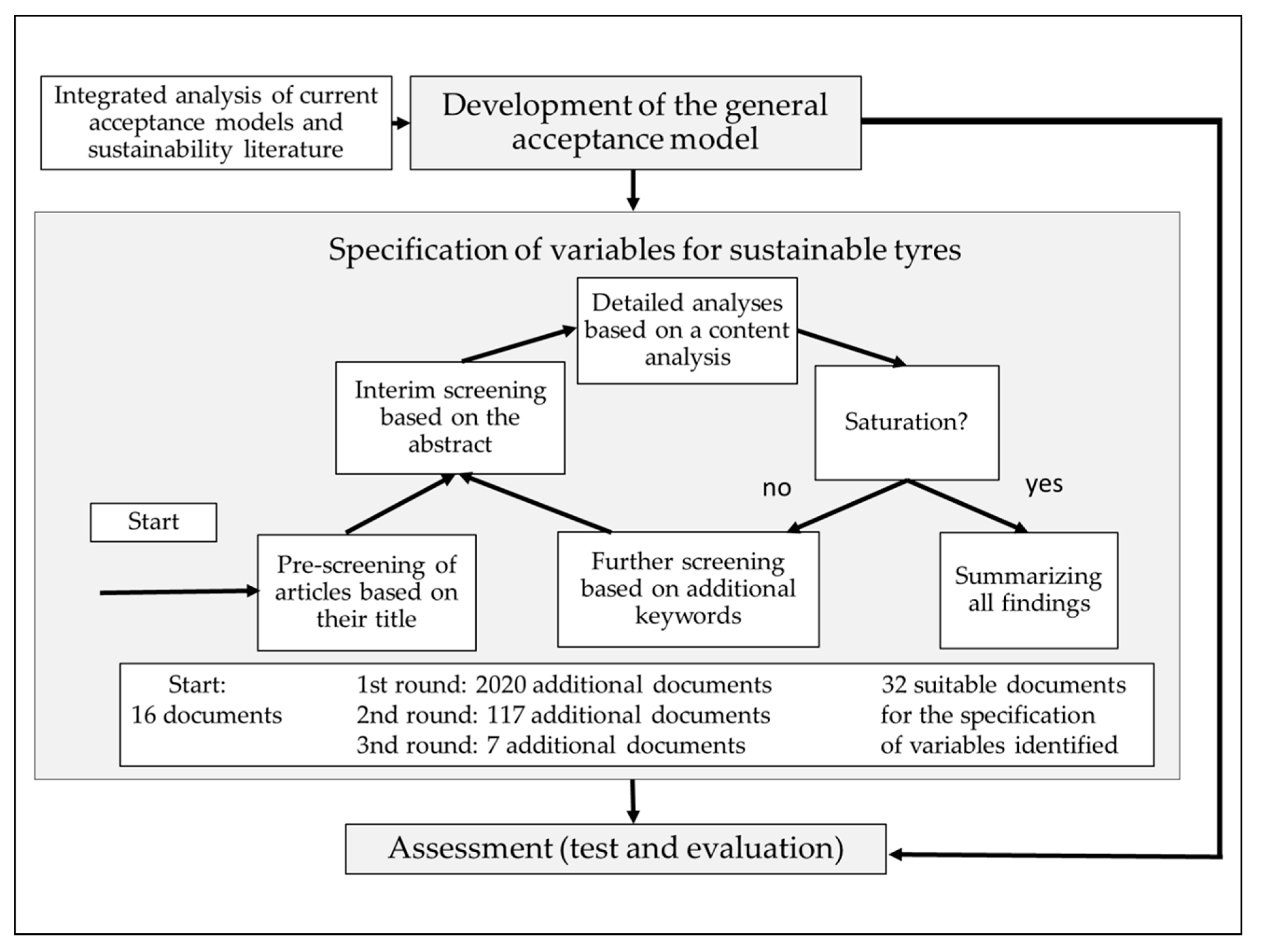
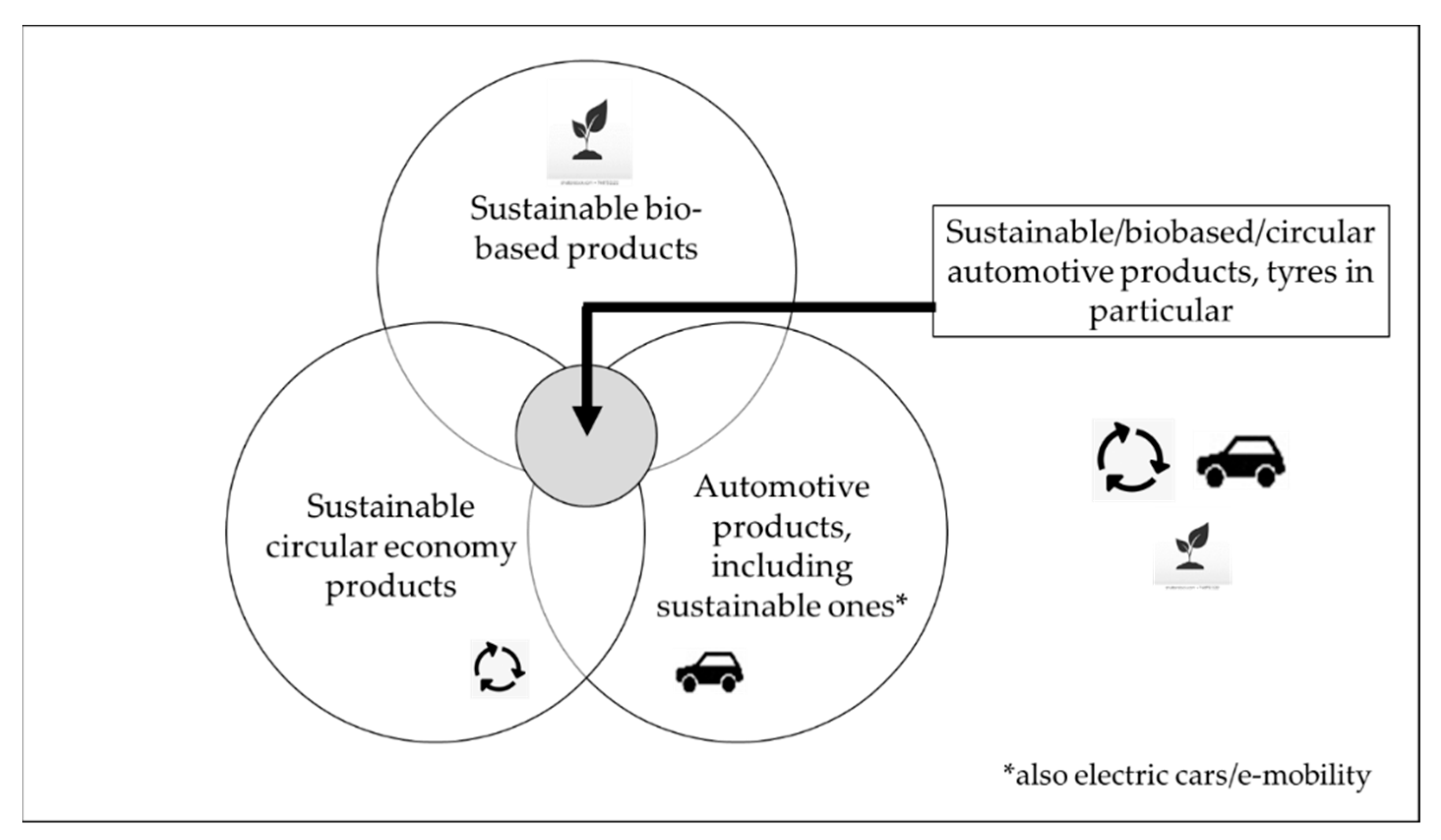

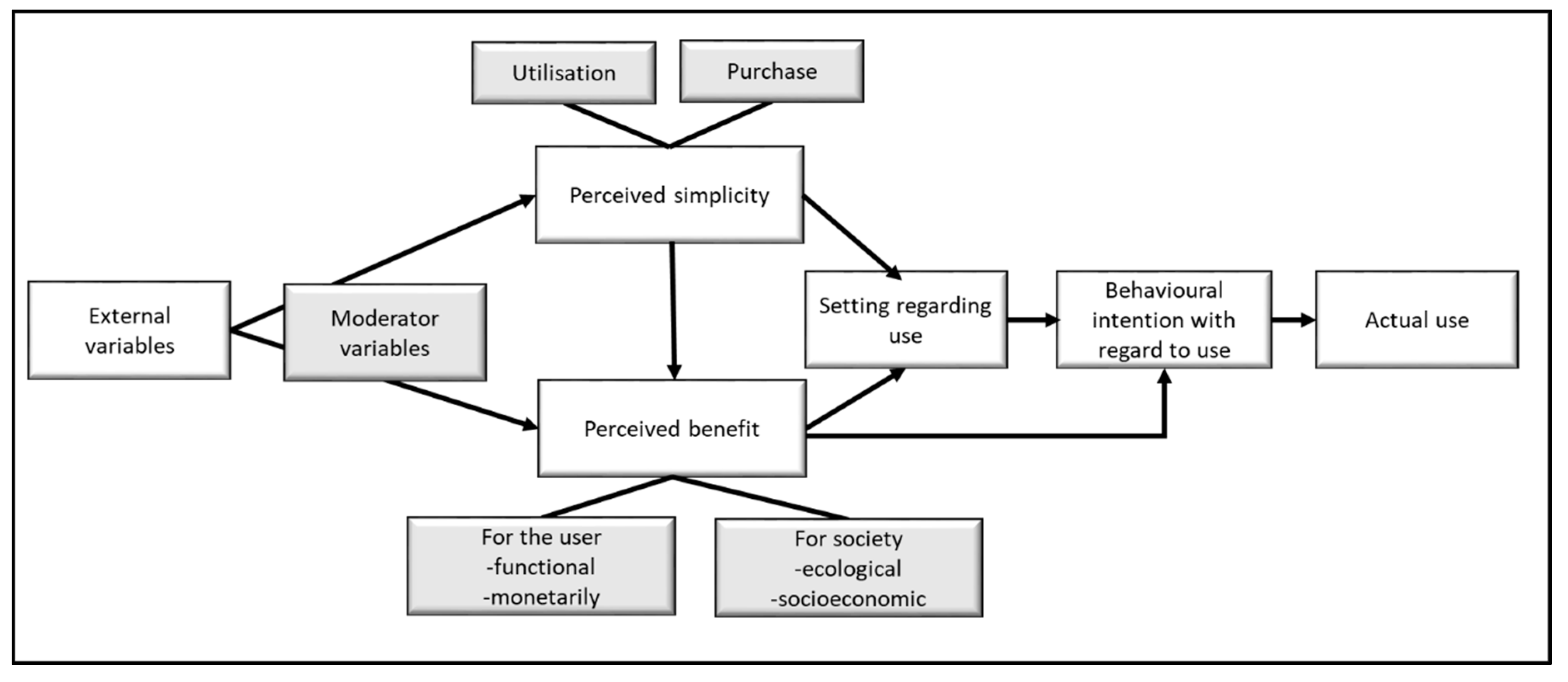
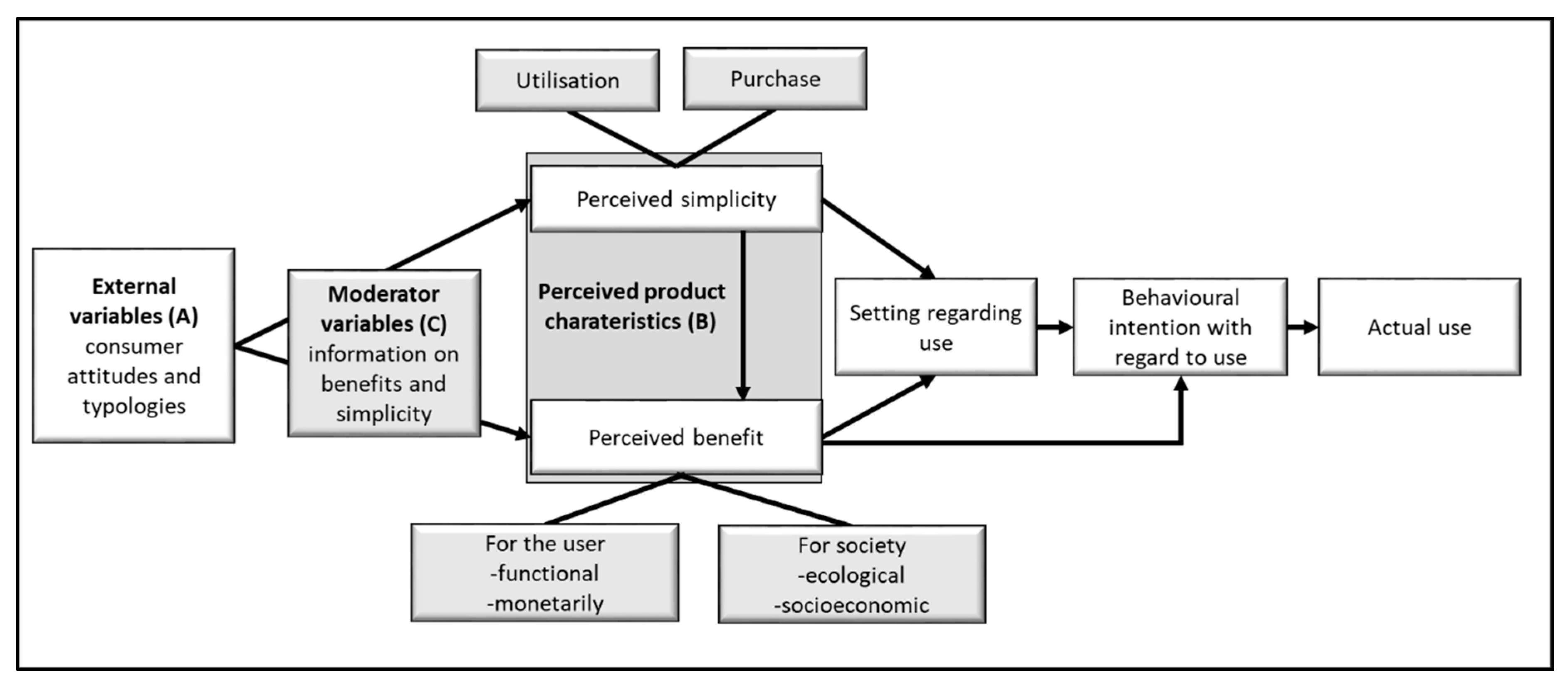
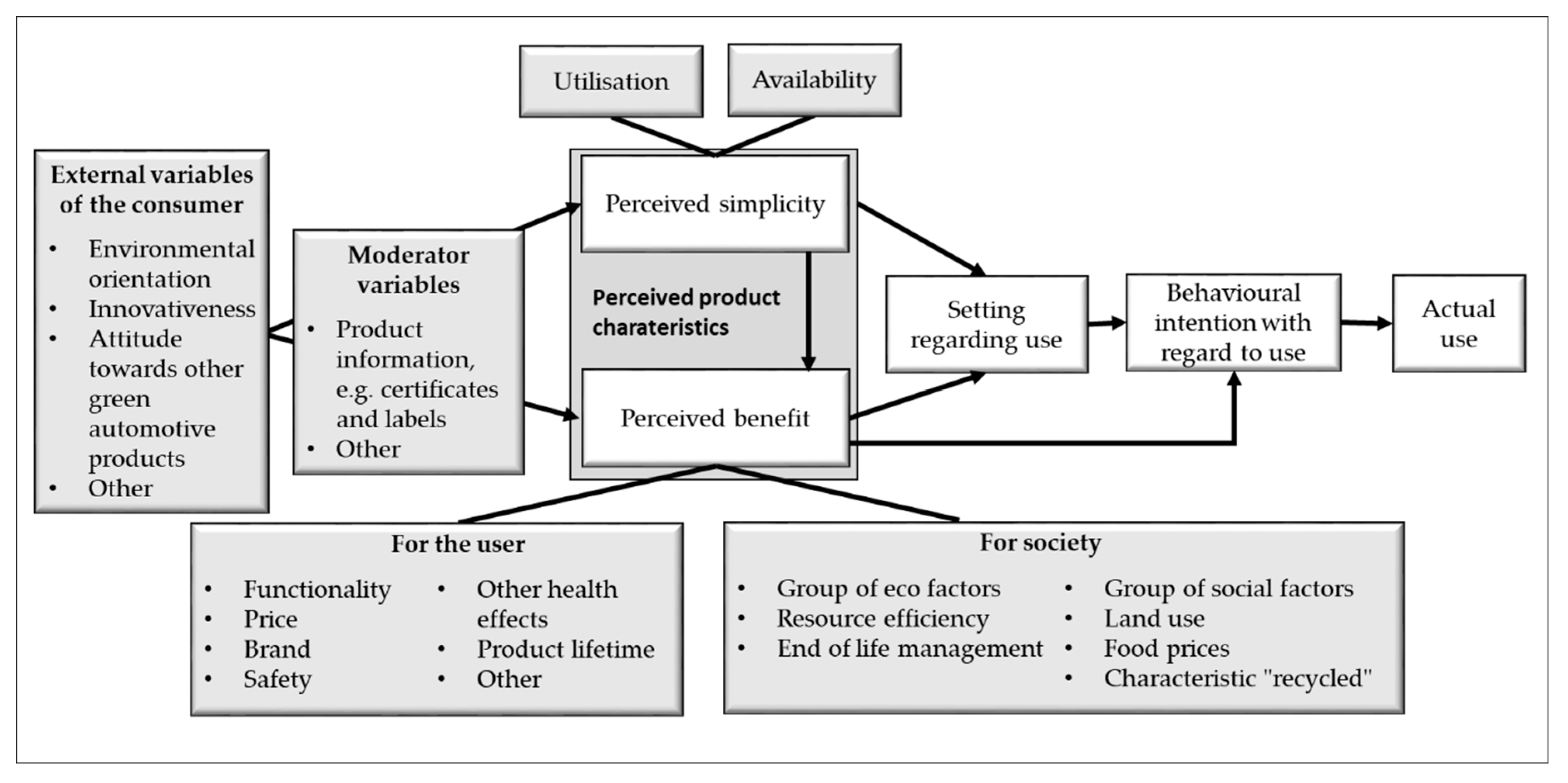
| Topic | Authors |
|---|---|
| Environmentally sustainable products | Bhate & Lawler (1997) [16], Axsen et al. (2012) [17], Bossle et al. (2016) [18], Medeiros et al. (2014) [19], Hanss & Böhm [20], Liobikienė et al. (2017) [21], Liobikienė & Juknys (2016) [22], Luchs & Kumar (2017) [23] |
| Bioeconomy | Bröring et al. (2017) [24] |
| CE | Camacho-Otero et al. (2018) [25], Camacho-Otero & Pettersen (2017) [26], Russo et al. (2019) [27] |
| BB products | Russo et al. (2019) [27], Sijtsema et al. (2016) [28], Carus et al. (2014) [29], Lettner et al. (2017) [30], Peuckert & Quitzow (2017) [31] |
| Electric vehicles | Adnan et al. (2017) [15], Schuitema et al. (2013) [32], Egbue & Long (2012) [33], Li et al. (2017) [34], Liao et al. (2017) [35], Moons & Pelsmacker (2016) [36] |
| Alternative fuels | Lanzini et al. (2016) [37], Linzenich et al. (2019) [38], Chang et al. (2015) [39], Li & McCluskey (2014) [40], Li & McCluskey (2017) [41], Moula et al. (2017) [42] |
| CE cars | Despeisse et al. (2015) [43] |
| Other (green vehicles’ digitalization) | Mihet-Popa & Saponara (2018) [44] |
| Other (life cycle assessment) | Tarne et al. (2017) [45] |
| Other (green information) | Wang et al. (2018) [46] |
| Comment: [46] was eliminated later. In contrast to the title, the authors write in the document that the article refers to laptops and not to cars. | |
| Category | Subject | Findings | Product range | Authors | |
|---|---|---|---|---|---|
| External variables related to the consumers (A) | Consumer attitudes and target group segmentation |
|    E  I  | [17,18,21,27,32,41], various other authors | |
| Price (in relation with consumer segments) |
| B  | [37] | ||
| Perceived product characteristics (B), Benefits | Functionality |
| E   | [25,33] | |
| Characteristics “BB" and "recycled" |
|  | [28,31] | ||
| Price |
|  B   | [25,29,40,41,38] | ||
| Brand |
| E    | [16,27,36] | ||
| Health impact for consumers |
|  | [28] | ||
| Safety and security |
| E  | [15,33] | ||
| Product life expectancy |
| [39] | |||
| Environmental factors (group approach) |
| I   | [28,31,39] | ||
| Environmental factor Resource-efficient |
|  | [24] | ||
| Environmental and social factor Waste exports |
|  | [43] | ||
| Social factors (group view) |   | [20,24,31] | |||
| Social factorland use |
| B  | [37] | ||
| Social factor land use, food prices |
| B  | [42] | ||
| Digitization |
| E  | [44] | ||
| Perceived product characteristics (B), simplicity | Availability |
| I    | [16,25,38] | |
| Moderator variables (C), information on benefits and simplicity | Functionality information |
|  | [25,28] | |
| Sustainability information |
| E   B  | [28,30,33,35,37] | ||
| Labels based on standards |
|  | [24] | ||
| Legend | |||||
| Automotive, Biofuels | B  | Automotive, innovative fuels | I  | Bio-waste products |   |
| Automotive in general |  | Bio-based (BB) products |  | Circular economy (CE) and recycling management |  |
| Automotive, Electromobility | E  | Bioeconomy in general |  | Environmentally sustainable products in general |  |
© 2020 by the authors. Licensee MDPI, Basel, Switzerland. This article is an open access article distributed under the terms and conditions of the Creative Commons Attribution (CC BY) license (http://creativecommons.org/licenses/by/4.0/).
Share and Cite
Wurster, S.; Schulze, R. Consumers’ Acceptance of a Bio-circular Automotive Economy: Explanatory Model and Influence Factors. Sustainability 2020, 12, 2186. https://doi.org/10.3390/su12062186
Wurster S, Schulze R. Consumers’ Acceptance of a Bio-circular Automotive Economy: Explanatory Model and Influence Factors. Sustainability. 2020; 12(6):2186. https://doi.org/10.3390/su12062186
Chicago/Turabian StyleWurster, Simone, and Rita Schulze. 2020. "Consumers’ Acceptance of a Bio-circular Automotive Economy: Explanatory Model and Influence Factors" Sustainability 12, no. 6: 2186. https://doi.org/10.3390/su12062186
APA StyleWurster, S., & Schulze, R. (2020). Consumers’ Acceptance of a Bio-circular Automotive Economy: Explanatory Model and Influence Factors. Sustainability, 12(6), 2186. https://doi.org/10.3390/su12062186




